
MAY CONTAIN NUTS

Search Shorpy
SHORPY ART

Framed or unframed, desk size to sofa size, printed by us in Arizona and Alabama since 2007. Explore now.
Join and Share
Ad-Free Shorpy
Shorpy is funded by you. Patreon contributors get an ad-free experience.
Learn more.

Recent comments
- Wowzers
- Treescaping
- Still Life With Operator
- +112
- Rear View
- Way in the back --
- Button It Up
- And with an eye on the time ...
- Working in an enclosed ashtray
- Rear View Mirror?
- Tobacco cam
- Basic fact I learned only later in life
- Put a Lid on it!
- Pinstripes in the Tower
- Sound enhancement
- 3438 in '38
- Second Career
- Their days are numbered
- Only the Sensor
- Train control mechanism
- Rarest of the Rare?? & Classy 3400 Class
- Control Mechanism
- Those standpipes
- Wrenches
- International D-40 I believe
- Job prospects
- You had me at Train
- Land of the free
- Broad-Exchange Bldg
- Parking innovation
Member Photos
The Shorpy
Printporium
Printporium
Search Shorpy
Search results -- 30 results per page
- Amarillo Yardmaster: 1943
- ... for almost twenty years as the yardmaster. During the night in our small town we could hear the trains pumping the cars in the ... from the train yard. There were numerous trains each night in both east and westbound moving along the system between Chicago and ... Posted by Dave - 08/10/2012 - 4:15pm -
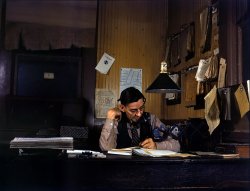
- Ashepoo P.O.: 1938
- ... The downside for the owner was that any time of the day or night, people who were in need of any given thing or service would pound on the ... Posted by Dave - 12/25/2017 - 10:40am -
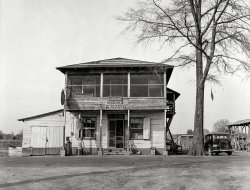
- Beer Boulevard: 1938
- ... entering and leaving the mill at the same time. Later that night, while trying to fall asleep in a guest bed at my grandparents' house, I ... Posted by Dave - 11/26/2017 - 12:49pm -
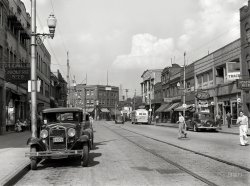
- Shooting the Bull: 1913
- ... fired at it which went wild and killed George Beattie, night watchman of the building under construction at 24 East 55th Street. ... ... Posted by Dave - 09/11/2011 - 10:16am -
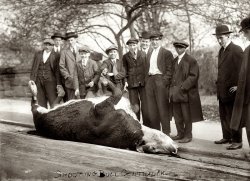
- Newsboys Club: 1909
- ... 1900 than for some time past; average attendance per night was 140 boys; total expenses for the year 1900, $1,755; total receipts, ... Posted by Dave - 07/08/2013 - 12:11pm -
![Newsboys Club: 1909 October 1909. Boston, Mass. "In the Newsboys Reading Room. Boys seated at tables playing games." Photograph by Lewis Wickes Hine. View full size.
Or perhaps CarromConsidering the cue used on the far right.
Possibly PitchnutLooks similar:
http://en.wikipedia.org/wiki/Pitchnut
Reading RoomIronic title, for kids who, were they not working at such a young age, ought to be in school.
Making it up as they goAlmost looks like a shuffleboard type of game, and the kid at the third table over is using a pool cue while the matronly lady looks on approvingly. Meanwhile the boy resting his head on his fist has the devil in his eyes.
Take me out to the Disc GameIt looks like they're playing Carrom, which I've only come across in Asian countries before so it's interesting to see it being played in this context. It's a little like playing pool but with discs instead of balls and I've seen it played with both a finger-flick and with a cue, which seems to fit the evening's activities. It's a real betting game - but probably not here!
[I'm not so sure about that -- gambling newsies were a staple of the Hine repertoire. - Dave]
From newsboys to business menIf the 10 Somerset Street address mentioned by Stanton_Square is correct, the address currently is home to Suffolk University Business School, two blocks from the Massachusetts State House. 15 Howard Street, between Andrew and Dudley Squares, looks to be an abandoned building today.
No video gamesA little reading, a lot of face-to-face interaction. Those were the days!
If Scrabble had been invented and they were playing itYou can bet one of the words challenged was "wuxtry". (Scrabble came along in the 1930s.)
Free Games and BathsA post at the Looking for Lewis W. Hine Photo Locales blog identifies the location of this photo as the Burroughs Newsboys Building at 10 Somerset Street. Earlier accounts report that the newsboys met on Howard Street.
Bacon's Dictionary of Boston, 1886.
Reading-room for Newsboys and Boot-blacks. 16 Howard Street. Open from 10 A.M. to 10 P.M. A resort where books, papers, games, and regular entertainments are furnished.
Massachusetts Bureau of Statistics of Labor, 1902.
Report of the Newsboys' Reading-Room Association on Howard Street showed the attendance to have been larger during 1900 than for some time past; average attendance per night was 140 boys; total expenses for the year 1900, $1,755; total receipts, $1,643. This association was formed in 1870, and serves as a reading-room for licensed newsboys. Entertainments, games, drawing classes, books and periodicals of all kinds, as well as bathing facilities, are offered the boys as inducements to join. Everything is free.
I Remember CarromWe had a Carrom board growing up in Nebraska in the 60s. On one side was a checkerboard and backgammon triangles. The other side had the setup for playing Carrom. It came with a couple of wooden cuesticks and a bunch of colored plastic rings, plus instructions for several games. In the four corners of the board were net pockets, and we played a billiard sort of game most of the time.
(The Gallery, Kids, Lewis Hine)](https://www.shorpy.com/files/images/SHORPY_05433u.thumbnail.jpg)
- Whistler's Brother: 1936
- ... acted with Clark Gable in the 1934 film "It Happened One Night". She won the Academy Award that year for best actress. You can read all ... Posted by Dave - 03/12/2013 - 12:01pm -
![Whistler's Brother: 1936 1936. High Point, North Carolina. "Housing. Bedroom in company-owned home of workers in Highland Cotton Mills. This is one of the best there." Who are the glamor girls on the wall? Photograph by Lewis Wickes Hine. View full size.
My guessI know that the photo above the vanity mirror is Claudette Colbert, who would have been 33 in 1936. I think the other picture is Alice Faye, who would have been 21. What is my prize?
[The respect of your peers? - Dave]
Glamor GirlLooks like Claudette Colbert on the left over the mirror.
Glamour GirlsClaudette Colbert is the one on the left. Patricia Neal favors the one on the right, but it is not her as she was only 10 in 1936.
Claudette ColbertThe photo on the left sure looks like Claudette Colbert, who famously acted with Clark Gable in the 1934 film "It Happened One Night". She won the Academy Award that year for best actress. You can read all about her life here.
Bride & GroomingThe pocket comb is early geek.
Right glamour girlMy vote for the one on the right goes to Ruby Keeler.
Star PowerFirst person to ID the leading ladies was David McMath of Birmingham, Alabama, on the Shorpy Facebook page at 2:02 p.m., three minutes after the image was posted. Impressive!
All right, BobHang your precious hussy pictures if you must, but put them high enough that I don't have to look at them!
Claudette ColbertThe question is why his wife allows him to have that picture?
[It's her bedroom, too. - tterrace]
Hang 'em HighOne does have to wonder why the photos and then why are they hung so very high on the walls.
(The Gallery, Lewis Hine)](https://www.shorpy.com/files/images/SHORPY_7496482236.thumbnail.jpg)
- Bar Harbor Panorama: 1901
- ... the sounds of the ocean coming in the barracks windows at night from Schoodic Point.
Tipping Point I hope Casanova was turning ... Posted by Dave - 10/14/2021 - 11:05am -
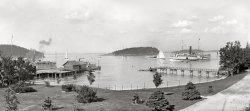
- Navy Fighters: 1897
- ... changed that much, just the sports. I've seen Friday night smokers during my 20+ years, and recently ('95) we had a rugby team on ... Posted by Dave - 08/05/2012 - 3:14pm -
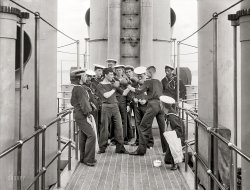
- Dallas After Dark: 1942
- January 1942. "Night view, downtown section. Dallas, Texas." Medium format negative by Arthur ... Posted by Dave - 11/02/2017 - 5:47pm -
![Dallas After Dark: 1942 January 1942. "Night view, downtown section. Dallas, Texas." Medium format negative by Arthur Rothstein for the Office of War Information. View full size.
Lane and CommerceIt seems I was off in my original post, this isn't Commerce and Lane, it's Commerce and Prather. The depth of field of the Google cameras can be quite different from the vintage photos.
'36 TerraplaneA 1936 Hudson Terraplane sitting at the curb.
The Magnolia BuildingThe main feature here is the Magnolia Building, completed in 1922. Headquarters for Magnolia Petroleum, later Mobil Oil, it was topped by the rotating, neon-lit Pegasus, put in place for the American Petroleum Institute's 1934 convention, hosted in Dallas. A replacement Pegasus sits atop the building today.
Back then, Pegasus was visible for miles, as it was when my mother moved in Dallas the next year. That year (1943), it would be eclipsed in height by the Mercantile Bank Building, the only skyscraper completed during the war, and the tallest building west of the Mississippi. Today the Magnolia Building is the Magnolia Hotel, and the Merc has been converted into apartments.
Pirouetting Pegasus Revolving atop the old Magnolia building, the red flying horse was a Dallas landmark for a couple generations. I remember competing with my brother to be the first to spot it as we drove into "Big D" on our semi-annual trips from Deep East Texas to Abilene. The return trip eastward usually put us in Dallas after dark and the glowing Pegusus was the halfway mark. I've heard they found and restored the neon sign and installed it at the Omni hotel downtown.
Does anyone remember the song Big "D", little "a", double "l"- "a-s" - may have been a jingle?
Goober Pea
John F. Beasley Construction CompanyThis construction company is still going strong in the Dallas area, but the building under construction on the right in our photo didn't survive.
Pegasus rebornHere's the story of the search for, and discovery and restoration of Pegasus.
It's now front of the Omni Dallas, according to this.
Big D, little aThe song "Big D" is from the musical "Most Happy Fella" by Frank Loesser. It's a delightful show, and popular among community theater groups. The same show also includes the show-stopping "Standing on the Corner" (as in "watching all the girls go by").
It's Actually the MercThe building under construction (directly across the street from Neiman-Marcus) did indeed survive, having been completed in 1942 as The Mercantile National Bank. It is presently 'The Merc' apartments. Here's a tidbit from their leasing brochure...
"The Merc is more than a place to live. It is a place of history, rooted in the city's legacy of entrepreneurship, industriousness, and the good life. Completed in 1942, the 523-foot Mercantile Tower with its stately clock and soaring spire was the home of the Mercantile National Bank, founded and owned by Dallas' powerhouse banker and civic leader, Robert L. Thornton. This landmark building has reclaimed its place of honor amidst Dallas' vibrant skyline".
The photo shows The Mercantile National Bank shortly after completion. Neiman-Marcus is directly across the street.
It's actually not the MercNot that it really matters, and not that I want to be contrary, but the building under construction would be in the 1500 block of Commerce, in a spot now occupied by a parking lot (and/or the building now at 1511 Commerce). The Merc is a block to the east of here. Love this photo - now I need to go take a look at the Pegasus next summer during the annual family trip to the Metroplex!
[You're off by two blocks. We're at the 1700 block of Commerce - note the address on the C.E. Hoffman Co. sign. Also, the building at the right, now with additional floors, is at the corner of Commerce and S. Ervay, immediately across S. Ervay from the Merc. -tterrace]
Dang - you're right! I did see the address, but ignored it when I agreed with a previous post that this was the corner of Lane Street, and could not see Ervay passing to the north. I think it's easy to get fooled by the foreshortening difference between these photos and Google street view cameras! I learn something every day from Shorpy! I also shouldn't try to post things when I'm up past my bedtime.
(The Gallery, Arthur Rothstein, Cars, Trucks, Buses)](https://www.shorpy.com/files/images/SHORPY-8b16323a.thumbnail.jpg)
- Flygirl: 1918
- ... her survive the often sub-zero conditions of open-cockpit night flying, but as a friend of mine immediately said when he saw this photo, ... Posted by Dave - 08/23/2012 - 11:40am -
![Flygirl: 1918 Washington, D.C., circa 1918. "Marjorie Stinson, aviatrix. Packard LePere plane." Harris & Ewing Collection glass negative. View full size.
DC aviatrix, into leather.Those shoes look like they belong on someone flying a broomstick.
Aviatrix,Dominatrix, whatever.
Sister MarjorieI think this is Katherine Stinson's younger sister Marjorie.
[I think you're right! Caption changed. Marjorie, not Katherine. - Dave]
Nice touchI'm betting pinkie rings were not all that commonly worn by women at that time. It gives her a kind of rakish air.
LOLAnd here I was just thinking that I wanted her shoes.
Fetching EnsembleMiss Stinson's careful fashion magazine pose and her knowing grin suggest that she had fun mocking the supposed strangeness of being a pretty young woman who was teaching combat flying to the Royal Canadian Flying Corps. The gear she's wearing would have helped her survive the often sub-zero conditions of open-cockpit night flying, but as a friend of mine immediately said when he saw this photo, "Where'd she get her outfit - Frederick's of Duluth?"
Women Who FlyI just finished "Women Who Fly" and now I find one of these forgotten pilots here. Thanks for the photo, as there were none in the book.
(The Gallery, Aviation, D.C., Harris + Ewing)](https://www.shorpy.com/files/images/11672a.thumbnail.jpg)
- Sid Caesar: 1922-2014
- ... only one or two seasons. It was reincarnated on Saturday Night Live with Christopher Walken as the Continental. It was a lot funnier, ... who will be soon to follow?
Live TV blooper One night during his live broadcast, the Continental mixed up his nouns and ... Posted by Dave - 02/12/2014 - 9:26pm -
![Sid Caesar: 1922-2014 Sid Caesar, Pioneer of Television Comedy, Is Dead at 91
A list of Mr. Caesar’s writers over the years reads like a comedy all-star team -- Mel Brooks, Woody Allen, Neil Simon, Carl Reiner, Larry Gelbart ... -- New York Times
New York, February 1952. "Your Show of Shows comedians Sid Caesar and Imogene Coca doing a skit about a couple watching 'The Continental'." From photos by Charlotte Brooks and Earl Theisen for the Look magazine assignment "Takeoff on 'The Continental'." View full size.
Uncomplicated TVThe Continental was an early 1950s TV show. The host, a European seductive type, invited women into his apartment for Champagne and and evening of pleasure, which included a movie. It lasted only one or two seasons. It was reincarnated on Saturday Night Live with Christopher Walken as the Continental. It was a lot funnier, but the 1950s show was, for its time, a bit risque, but tame by today's standards. Sid & Imogene's take on it must have been riotous at the time.
[Obscure fact I had to look up: The Continental was played by one Renzo Cesana. - Dave]
The cameraThat's a nice close-up of an RCA TK-10 camera. The knob and the hole at the lower left corner are not factory. Back then, studio engineers did a lot of actual engineering, making the equipment work better than new.
A true pioneer in television comedyUncle Miltie might have been first funnyman on the airwaves, but Sid took it to the next level.
His trusty sidekick went on to play Aunt Edna in the first 'Vacation' movie.
What a pair! Back when you had 3 channels to pick from, think of the percentage of American homes that were laughing along with them.
The Continental, SNL style....
First ShirleyAnd now Sid! It is strange how we seem to lose the greats in clusters of three! I wonder who will be soon to follow?
Live TV blooperOne night during his live broadcast, the Continental mixed up his nouns and supposedly said "the stockings do for your face what the powder does for your legs."
It's a Mad, Mad, Mad, Mad WorldWorth watching to catch all those wonderful comic actors doing their cameos. Caesar was a hoot, especially in the basement of the Hardware Store! He will be missed, thank goodness for YouTube and DVDs.
Grindl!I had the incredible pleasure of meeting Imogene Coca when she was appearing in "On the Twentieth Century" opposite Rock Hudson when it was playing in San Francisco in about 1979 or 1980. As manager of a local theatre production, I was able to go backstage on several occasions and chat with her. Once I told her that I should have asked her to autograph a program as "Grindl." She laughed, and said I was too young to remember that! But I actually remember her in Show of Shows, when everyone came over to our house to watch one of the only TVs in the neighborhood.
She was a delightful woman, and I miss her!
Rock Hudson, on the other hand, was brusque, and not really suited to the part he was playing on stage. The best performance I saw of that show (I saw MANY!) was with his stand-in.
(The Gallery, LOOK, TV)](https://www.shorpy.com/files/images/SHORPY_01619u.thumbnail.jpg)
- Reliable Shoe House: 1920
- ... business at 930 and 932 Seventh street yesterday and last night be a formal opening, that was attended by great crowds of people. The ... Posted by Dave - 09/03/2012 - 11:52am -
![Reliable Shoe House: 1920 Washington, D.C., circa 1920. Hahn's shoe store at Seventh and K streets N.W. View full size. National Photo Company Collection glass negative.
Hahn'sThe building still exists, and the shoe store closed only about 10-12 years ago. I used to buy all my shoes there, including my first grown-up shoes for my first job, for a law firm across the street.
That is neatI would give my bottom dollar to have seen what new-old-stock they had available when they closed down. Size 8 please...
Hahn Shoes: 1891 The Washington Post, Oct 13, 1891
William Hahn & Co. Formally Open Their New Establishment
William Hahn & Co. celebrated the occupation of their new place of business at 930 and 932 Seventh street yesterday and last night be a formal opening, that was attended by great crowds of people. The new building, which was demanded by the increasing trade of the firm, was built expressly for them. It is a beautiful structure, three stories high, and every available foot of space is devoted to the large assortment of goods handled by the firm. The fixtures are of oak, and the office cashier's box, and wrapping counter in the front of the main salesroom are an innovation on the usual methods of construction. The fixtures, for both gas and electricity, are black and form a pleasing contrast to the thousands of white boxes containing shoes. ...
Hahn Shoe DCThe corner occupied by Hahn is the SW corner of Seventh Street and Massachusetts Avenue NW. K Street goes west to Seventh and stops at Mount Vernon Square, where Carnegie City Library was built. K restarts west of Ninth Street all the way to Georgetown.
[This is Seventh and K, not Seventh and Mass. - Dave]
Hahn'sHahn shoes ware the best. Someone should start a Facebook for all Hahn's-related stuff.
You Are HereThe address is also in the medallion on the corner of the building.
The old hotfootHahn's shoe store was destroyed by a five-alarm fire on December 12, 1937.
Luther Reason RayI found a design by architect Luther Ray while researching him in the Library of Congress archives. It appears to have been either a plan for a remodel of a this building or one for a replacement. Do we know if it was ever built?
(The Gallery, D.C., Natl Photo, Stores & Markets)](https://www.shorpy.com/files/images/30556u_0.thumbnail.jpg)
- A Sterling Reputation: 1915
- ... pay off the balance he owed Galt & Bro. Jewelers the night he was shot; the Galt family took back some of the items the president ... Posted by Dave - 08/08/2012 - 1:35pm -
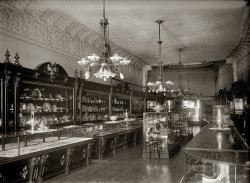
- Trick-or-Treat: 1957
- ... keep track of the "Zorro" episode on ABC-TV that Thursday night). The prior year had been my last in the "gathering mode" (in a group of ... to one-up, but I don't think we even had that $5 for a one-night costume. Gosh I got so tired of being a hobo every year...
Cost of ... Posted by tterrace - 06/24/2009 - 5:09pm -
![Trick-or-Treat: 1957 Halloween 1957, or "Tterrace and the Haunted Door Lock." Must be a dry run, since it's still daylight outside. My sister did the pumpkin decoration with an early felt-tip marker, and took this 2-1/4 square transparency. I'm 11. View full size.
Costumes cost a lot less back thenMust be the good old days when you made your own costume, and the total cost of the costume material was less than $5. These days, an 11-year-old cannot even purchase a DECENT (retail) costume for under $30. How times have changed.
[How well I remember my own mother seated at her spinning wheel next to the TV, whipping up a skeleton costume for Little Dave. Silk-screening the bones was the hard part. - Dave]
Halloween 1957That year, at age 10, I was on handing-out-candy duty (while trying to keep track of the "Zorro" episode on ABC-TV that Thursday night). The prior year had been my last in the "gathering mode" (in a group of about a half dozen) - nicely amassing nearly 2 large bags' worth and getting back in time to watch the Disney "Halloween Special" while sorting my goodies.
My Mother TooGee, up until now I thought my Halloween costumes had been store bought. Bless my mother.
Cost-umeFunny, I was at our local Long's Drugs the other day and reflecting on the amazingly inexpensive price of the outfits! I made nearly all my kids' costumes (I don't sew, but they never wanted to be anything easy! I have become a master of papier mache masks) and now for my grandkids. It adds up fast! In contrast, the store-bought costumes retailed for $16 and were half price, accessories included! Eight bucks looked really good to me right then, as I was paying $10 for just the dye I needed. And I can't think of anything else that you can get now for $8 that was $5 in the 1950's! Great photo as usual, Tterrace!
Had Two Sticks ... but no CostumeNot trying to one-up, but I don't think we even had that $5 for a one-night costume. Gosh I got so tired of being a hobo every year...
Cost of costumesIf a costume cost anywhere near $5 in 1957, it would have been extra special! I never had a store bought costume nor did my mother make me any. I scrounged up what I could find--usually old clothes, and a bandanna hanging on a stick.
Dave--your mother must have been a saint!
My Mom tooFirst Halloween costume I had my mother made and she didn't even sew! That was in 1953. All I remember is my mother sitting at the sewing machine sewing black and yellow material. I can't remember what the costume was however. No picture either. I don't think she ever did it again. I never had a store-bought costume that I can remember. It was always something I or my mom thought of and put together. I have wonderful Halloween memories. I hope you all had a wonderful Halloween!
NewspaperWhat's the shredded newspaper for?
The Pumpkin PapersWhat's the shredded newspaper for, you ask? It's the jack-o'-lantern's hair. Part of my sister's overall design concept.
(ShorpyBlog, Member Gallery, Halloween, Kids, tterrapix)](https://www.shorpy.com/files/images/halloween_0.thumbnail.jpg)
- Message Received: 1943
- ... is not wanted in any locomotive cab - it cuts the crew's night vision.
Timing Does anyone know how fast this train would have ... Posted by Dave - 06/06/2015 - 1:10pm -
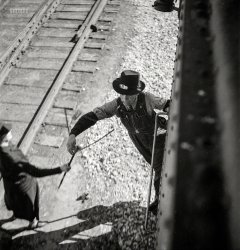
- Frank and Bacon: 1924
- ... combination. Nourishing for breakfast. Satisfying at night. And popular with every appetite all winter long. Think how easy it is to ... Posted by Dave - 05/17/2014 - 10:59pm -
![Frank and Bacon: 1924 Washington, D.C., circa 1924. "Stephen Frank -- Auth Provision Co., Center Market." National Photo Company Collection glass negative. View full size.
Razed in 1931The block that Center Market occupied is now the home of the National Archives. D.C. still has markets like this. There is the more upscale Eastern Market, the oldest continuously operated fresh food market in the country.
When Center Market was torn down, it was to make way for something more "modern" -- the self-service supermarket, where all the the individuals vendors in stalls were replaced by "departments" under one brand name roof. The 1930s saw an explosion of the chain grocery system, and Center Market was simply too old-fashioned. Too bad the owners had no idea that 50 years later, that antique system would be a tourist attraction.
Still Around!Looks to be some tasty slabs of bacon he has his arm on. Possibly head cheese, salamis, and kolbas too.
Thankfully, these types of markets still exist.
Cleveland has one that closely resembles this photo. With many and varied vendors under one roof, each with their fresh specialty. It beats any supermarket, hands down.
http://www.westsidemarket.org/
Detroit has its Eastern Market. It's not under one roof -- it much too large. It's an enjoyable adventure on a Saturday morning.
http://www.detroiteasternmarket.com/
Any others out there?
Despite the cleanlinesslet us hope the temperature in there is a blistering 20 below.
Agree on the BaconSo when did they start producing the fat slabs they now call American bacon? Look at the bacon sold online at those ethnic grocers. Really like these old "market & store" type photos.
O StreetEastern market in DC still has this feel. Of course, the bacon slabs are in coolers behind glass now.
I am not sure this photo was taken at Center Market. The "O" Street address in background suggests that it was actually taken at the Norrhern Market, which was also called the O Street market.
[Look again. The sign says "Branch of" the main store at 620 O Street. - Dave]
Harry Potter and the Half-Baked Hollywood HamNotice the young man to the right of the hanging scales. Is this a young photo of George Burns, before he took up his alter ego as Harry Potter?
Cleanlinessdoes not seem part of his remit, given the state of his apron.
Center MarketThe wonderful, cahotic chaotic Center Market was located on Pennsylvania Avenue where the Natioanl National Archives is now. A breif brief histroy history of it can be found here.
I'll take 18 pounds of old Leather Handbags please.
Bacon and BraunschweigerThe sign fragments in the photo are Berkshire Sausage and Charles B. Althoff, 620 O St. N.W., dealer of bread, pies and cakes. The faded sign is N. Auth Prov'n Co., Wholesale & Retail. Smaller signage includes Positively No Checks Cashed and These Stands Close Sat. at 6 P.M. During June, July & Aug.
Washington Post, October 19, 1924
Ask For Auth's Always!
Steaming hot, crisp, tender, nutritious — just as good to your stomach as it is to your tongue. No wonder thousands of well-fed families start the day with Auth's Sausage Meat regularly.
Auth's Pure Pork Sausage Meat with hot cakes — is the ideal cold weather combination. Nourishing for breakfast. Satisfying at night. And popular with every appetite all winter long. Think how easy it is to prepare, too. In less than fifteen minutes, you can have a real meal.
Auth's Sausage Meat
Other Auth Products: Frankfurters, Pork Sausage, Scrapple, Smoked Ham, Bacon, Pure Lark, Pork Pudding, Cooked Ham, Royal Pork, Braunschweiger.
(The Gallery, D.C., Natl Photo, Stores & Markets)](https://www.shorpy.com/files/images/SHORPY_29263u.thumbnail.jpg)
- The Nursery: 1915
- ... And There Is the Closet Whence the monsters emerge at night.
Despite the Negative Comments I wouldn't mind having one of those ... Posted by Dave - 11/05/2014 - 8:40pm -
![The Nursery: 1915 "Nursery" is all it says on this 4x5 inch glass negative, which comes to us from a seller in Minnesota. Maybe someone with the right connections could run a check on these fingerprints. Probably from around 1910-1920. View full size.
Nursery AccoutrementsPaint (lead, no doubt) chipping off cribs, screwdrivers and awls on changing table, picture of dead fish on the wall. What a lovely nursery!
RunawaysI am sure the children ran away. The place is a deathtrap and the still life on the wall is enough to make me run.
Nasty cribsWidely spaced bars, probably painted with lead. Tools on the dresser, pictures of fish on the wall.
Looks like a nursery from a horror movie.
It Looks Fishy To Me.Is that a picture of dead fish on the wall next to the mirror?
[As noted below by the cultured Kait, that is a STILL LIFE. - Dave]
FingerprintsThe nanny did it. No, wait -- the nurse. Okay, then -- the photographer.
Nursery of the NastyIt is hard to believe that our ancestors made it through things like this to allow us to be born! Scary!
The devil you say!This is where Rosemary had her baby.
Looks like a nursery from a second-rate orphanage.Linen on the beds is clean, but the beds themselves are shabby. Too many clothes apparently hung up on pegs in the closet.
[I wouldn't go anywhere near those beds without a tetanus shot. -Dave]
Early indoctrinationFishing is the state pastime in Minnesota (along with hunting). Kids had to be indoctrinated from the cradle . . .
And There Is the ClosetWhence the monsters emerge at night.
Despite the Negative CommentsI wouldn't mind having one of those wrought-iron cribs to refinish. The brass work on them was quite nice, too.
On the other hand, I wouldn't be saying, "Bloody Mary" three times in that mirror!
(The Gallery, Found Photos, Kids)](https://www.shorpy.com/files/images/SHORPY-141105-0006.thumbnail.jpg)
- A Toast: 1940
- Summer 1940. "'Venetian Night' party at the Detroit Yacht Club, whose members represent the wealthier ... Posted by Dave - 12/31/2012 - 11:03pm -
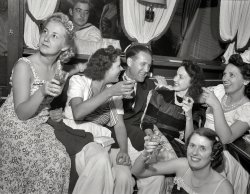
- Perry Mason: 1958
- ... Studios on La Brea Avenue.
A stalwart of Sunday night television in the UK in the sixties.
Lassie's Mom? I was sure ... Posted by Dave - 07/19/2014 - 12:01pm -
![Perry Mason: 1958
The Case of the Gilded Lily
April 4, 1958. "Photographs show actor Raymond Burr filming his television show Perry Mason with co-star Barbara Hale and others. Also includes Burr memoriz­ing lines with dialogue director Don Gardner; with executive producer Gail Pat­rick. Also Burr entertaining friends at his Malibu, Calif., home; feeding and playing with his pet dogs, duck, and burro; at the beach; helping move a large tree at the Mor­gan Nurseries." From photos by Maurice Terrell and Robert Vose for the Look magazine assignment "Raymond Burr: Perry Mason's prisoner." View full size.
USO gigWhen I was stationed on Guam, 1953-54, Raymond Burr came with a USO troupe. He was emcee and did a funny skit that would be R-rated today. The guys loved it.
The Perry Mason Drinking GameAs the story unfolds, answer the following questions:
1. Who gets killed? (hint: nobody nice).
2. Who gets falsely accused?
3. Who did it?
4. How did Perry know?
Special bonus question: is the confession going to be a bang ("I could have killed him a hundred times!") or a whimper ("I had to do it. Don't you see ... I had to")?
Brought to you by the Perry Mason fan club, a disorganized organization whose efforts have resulted in Raymond Burr being the most popular actor on Netflix.
The Case of the Fiery Fingers?Broadcast 5/3/1958? If I'm wrong, please don't hold me in contempt, Judge!!!
[Nope. Next! - Dave]
Very PerryI had always thought it strange that he jumped into the part of suave Perry Mason, remembering him previously playing smaller parts as a sleazy/slovenly type in Westerns, etc. He almost didn't get the part because he was too heavy, and therefore went on a severe diet, losing the weight to capture the part. When he auditioned, author Earl Erle Stanley Gardner shouted, "That's him! That's Mason!" My mother never missed an episode.
The Case of the Venerable Venue"Perry Mason" was filmed at Charlie Chaplin Studios on La Brea Avenue.
A stalwartof Sunday night television in the UK in the sixties.
Lassie's Mom?I was sure that was June Lockhart directly behind Burr, so I looked her up on IMDB to see if she had ever been in a Perry Mason episode. She had, but in 1964. I still think that might her in the photo -- maybe uncredited?
[That's Barbara Baxley. -tterrace]
Only LossPerry Mason Esq only lost one case, 'The Deadly Verdict', October 17 1963, and as The New York Times said after reviewing the preshow hype and writing that Perry would lose: "Presumably this is the first time in six years that . . . Burr has been called upon to register surprise."
[Three, actually. Sort of. -tterrace]
3 Weeks Later"The Case of the Gilded Lily" aired May 24, 1958, on CBS opposite The Dick Clark Show on ABC, and Art Linkletter's People are Funny on NBC.
Amana loveDella Street is so awesome that I am proud to own an old Radarange cookbook.
(The Gallery, LOOK, TV)](https://www.shorpy.com/files/images/SHORPY-04219u.thumbnail.jpg)
- This Land Is Your Land: 1939
- ... over their track. In June, you could probably get a decent night's sleep....
A sad time but he's makin' the best of it. ... Posted by Dave - 07/24/2012 - 9:38pm -
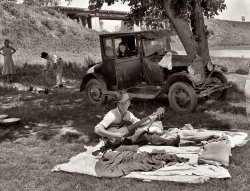
- Trenton Pinsetters: 1909
- ... Bowling Alley, Trenton, New Jersey. Photo taken late at night. The boys work until midnight and later." Photograph and caption by Lewis ... Posted by Dave - 12/10/2007 - 3:11pm -
![Trenton Pinsetters: 1909 December 20, 1909. "Boys working in Arcade Bowling Alley, Trenton, New Jersey. Photo taken late at night. The boys work until midnight and later." Photograph and caption by Lewis Wickes Hine. View full size.
Interesting...mix of regular and duckpin bowling on adjacent lanes.
Denny Gill
Chugiak, Alaska
Duck pinsMy Dad told us kids that he once worked in a bowling alley setting duck pins. Didn't say how much he was paid or anything else about this job. This would have been in the 1930s in or around Clairton, PA, south of Pittsburgh. Later he would work as a hod carrier and parking cars in a parking garage before joining the Marines in 1940. He had a lot to say about these jobs.
Joe Bartolini
West Columbia, SC
PercussionThose duckpins look like upside down maracas.
Duck PinsDuck Pins is still a fairly popular variant of bowling in some areas. It's the preferred version in Quebec for example. Candle Pins (where the pins are basically straight tubes with only a slight bulge in the middle) is the found mostly in Eastern Canada and New England.
Concentrate!Those kids must have been very distracting to the bowler.
[I think they stayed behind the tarps until the ball came through. - Dave]
The Tarps *I wouldn't bet on the pin setters dropping behind the tarps. Those are there to take most of the momentum from the balls so that they drop into the pit at the end of the alley. Needless to say the balls hit there with a pretty substantial force. Standing behind them and having limited visibility would be dangerous when some guy is hurling a 16 lb. bowling ball at you. As I understand it most later bowling alleys had a platform above the alley like the one these kids are sitting on but it had a sort of screen or wall in front of it. When a ball went through the kids would drop down set the pins and jump back up all while hoping that some sadistic SOB wasn't throwing another ball to hit them.
[There are a few photos of the kids coming out from behind the tarps, which are not fastened at the bottom. - Dave]
(The Gallery, Kids, Lewis Hine, Sports)](https://www.shorpy.com/files/images/03368u.thumbnail.jpg)
- Family Cookout: 1963
- ... of the folks who worked there.
I'll never forget one night just before closing time when he came to the store where I worked. He and ... Posted by Dave - 08/28/2016 - 2:57pm -
![Family Cookout: 1963 1963. "George Jenkins, founder of the Publix supermarket chain, with his family at their home in Lakeland, Florida." 35mm negative by Marvin Newman for the Look magazine assignment "George Pleasures Them With Groceries." View full size.
Aging and AgesI was struck by how much older George Jenkins looked in this photo than his wife Anne. Then I discovered the reason: he was 17 years older than she was. Anne died in 1998 at age 74 as a very wealthy lady.
Some sadness afflicted this family despite their tremendous personal wealth. Earlier this year it was announced that Carol Jenkins Barnett, who was born in 1959 and so is likely the girl on the right in this picture, stepped down from the Publix board of directors due to early-onset Alzheimers at age 59. George and Anne's son Kenneth, born in 1952, died in 1974.
George was a gentI was lucky enough to work for Mr. Jenkins' Publix firm for many years, and he was a wonderful person and a brilliant marketer. He had decided opinions, like not opening Publix stores on Sundays.
He'd stop in the stores unannounced and never failed to remember the names of the folks who worked there.
I'll never forget one night just before closing time when he came to the store where I worked. He and his wife had been divorced for some time when this occurred. Mr. George had a lovely blonde in his white Lincoln, and he dashed into our store to get a jar of peanut butter and a loaf of bread. He paid for those and off he went!
Mr. George seemed to me, in spite of his accomplishments, almost a shy man. The Publix chain was clearly an extension of his personality and his deep respect for the customer. He put together a leadership cadre that was absolutely committed to quality.
This summed up his manner, in my opinion: At the grand opening of the remodeled Publix #76, in Naples, Florida, I saw a customer put a couple of items in her purse. The policy was to keep a shoplifter under surveillance until they left the store without paying for whatever they took, and I passed Mr. George as I followed this person. He instinctively knew what I was doing, and said, "Here's a better way to handle it."
He took a large glass jar of our private-label peaches and handed it to the woman, saying, "Ma'am, I'm George Jenkins and I'm proud you're here today. I'd like to give you this jar of our new line of peaches. If they aren't the best you've ever had, please let Bob, your store manager, know, and he'll let me know." I followed the woman as she went back to the aisles where she had gotten the stuff in her purse, and watched her replace the items on the shelves. Later, I told Mr. George what she had done, and he quietly said to me, "She might shoplift again, but I bet it won't be at a Publix."
Seven kidsJenkins and his wife Anne were married in 1947 and had three boys and four girls. The oldest one beside Mom could be no more than 16. So the parents had another kid yet to come? Anyway, they divorced in 1974. I also love those steaks and the briquets and the lighter fluid, not to mention the older boys' hair and Mom's bathing suit.
[George and Anne had six children, three boys and three girls. The seventh child was a stepdaughter from a previous marriage. - Dave]
Publix #1was in the town I grew up in in the 1960's. I was probably the same age as the oldest boy in this picture. It was built in 1930. In the mid '50s they moved Publix #1 to the Northgate Shopping Center, and turned the old building into a Morrison's cafeteria. It's still there and a thrift store now.
Yabba dabba doThose are some Flintstone-style steaks!
Wow, that article title was clearly not thought through"George Pleasures Them With Groceries" could win an award for the worst article title ever.
[Publix's slogan is "Where Shopping Is a Pleasure." - Dave]
Never thought I'd seeDapper Mr. G posing in anything other than a suit, like in his portrait that adorns the wall of every Publix.
(Florida, LOOK, Swimming)](https://www.shorpy.com/files/images/SHORPY-50186a.thumbnail.jpg)
- Marfak Lubrication: 1960
- ... fellow is describing to the cop the getaway car from last night's holdup.
This Old (Gone) House At least one of the houses behind ... Posted by Dave - 06/06/2022 - 12:00am -
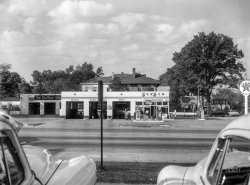
- High Society: 1939
- ... 1939. "Henderson, Adrienne, Miss, portrait." The town, a night on, ready for. Harris & Ewing Collection glass negative. View full ... Posted by Dave - 09/13/2011 - 10:57am -
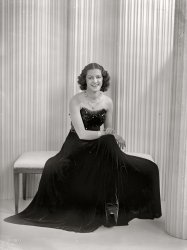
- Five-Tube Chassis: 1937
- ... superheterodyne receiver. We were on Long Island but at night that beast could pull in the race results from Bowie in Maryland and ... Posted by Dave - 05/05/2013 - 7:57am -
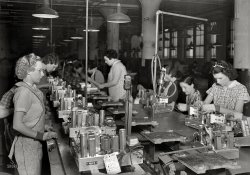
- Dry Humor: 1916
- ... Amendment, charged in a statement made public last night.
...
Representative Cramton, of Michigan, House dry leader, Capt. ... Posted by Dave - 09/12/2011 - 1:39pm -
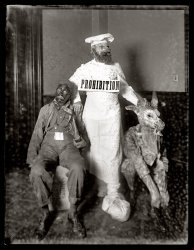
- Pere Marquette: 1910
- ... re-entered service September 8, 1910, sailing late that night to Milwaukee with twenty-nine rail cars aboard. At 3 AM she began taking ... Posted by Dave - 07/20/2012 - 3:42pm -
![Pere Marquette: 1910 The Chicago River circa 1910. "Pere Marquette transfer boat 18 passing State Street bridge." Railcar ferry built in a record 90 days after its namesake sank in Lake Michigan. Detroit Publishing Company glass negative. View full size.
Father MarquetteThe first Pere Marquette 18 was built 1902 at Cleveland by the American Ship Building Company. During the summers of 1909 and 1910 the Pere Marquette Railway chartered this vessel to a group from Grand Haven, Michigan, known as the Chicago Navigation Company and who placed her in the excursion trade between Chicago and Waukegan. A rail ferry that ran across Lake Michigan from Ludington, Michigan, to points in Wisconsin, her car deck was used as a dance floor and rumored to also house gambling operations. Returning to Ludington after Labor Day, she re-entered service September 8, 1910, sailing late that night to Milwaukee with twenty-nine rail cars aboard. At 3 AM she began taking on water which the pumps could not handle. At around 4 PM her captain sent out a CQD (forerunner of the SOS) distress message by wireless, attracting the vessel's near-sister, the Pere Marquette 17, which attempted to maneuver close enough to the stricken Pere Marquette 18 to remove passengers and crew. Suddenly, a little after 7 AM, her stern plunged beneath the water and she went straight down in a matter of seconds, it estimated twenty-seven to twenty-nine lives lost.
The Pere Marquette ordered a replacement immediately. Incredibly, the second Pere Marquette 18 was launched at the South Chicago yard of the American Ship Building Company on December 20, 1910, and entered service the next month. Removed from service 1954, as a little kid I recall her sitting forlornly on Pere Marquette Lake at Ludington until she was towed to Hamilton, Ontario, in 1957 for scrapping.
The tug T. T. Morford shown was built 1884 by the Miller Brothers at Chicago, and her design proved so successful that she became the model upon which almost every subsequent Chicago harbor tug would be built.
PM18 (II)Launched December 20, 1910, in Chicago. More here.
T T MorfordThe TT Morford was a tugboat with an interesting history:
The tugboat T.T. MORFORD was built in 1884 at Chicago and served the area faithfully until 26 October 1895, when her boiler exploded. She was rebuilt and went back into service adding another strange twist to history, for it was this same tugboat that 14 years later would rescue 20 or more people from Chicago's 68th Street Water Crib Fire. A fire which killed 60 men in January of 1909.
The vessel shownis the first Pere Marquette 18 while chartered to the Chicago Navigation Company, taking summer excursionists to Waukegan, to clarify my earlier post. The second Pere Marquette 18 remained exclusively in the rail trade between Ludington and Wisconsin ports its entire career.
[Why do we think this is the first Pere Marquette? - Dave]
An Excursion?Seems to be a significant number of the fairer sex aboard, and the ship seems to be riding very high in the water, so I don't think it has a load on. The ship was launched December 20, and arrived in Ludington Michigan on January 30 - it sure doesn't look like mid winter in the picture - perhaps a spring or summer excursion for railroad employees? There's even a bass drum on board, right above the 'P' in the ship's name.
[Midwinter would be February. December 20 is (barely) fall. But yes, it was chilly -- the high was 32, so this is probably not launch day. It may not even be launch year. - Dave]
The control houseseems to match that of the first PM 18:
http://www.carferries.com/pm/PM18/
vs PM 18 (II):
http://www.carferries.com/pm/PM182/
(The Gallery, Boats & Bridges, Chicago, DPC)](https://www.shorpy.com/files/images/4a18153a.thumbnail.jpg)
- Splinter Alley: 1925
- ... Nevitt's men are to assemble at the armory. He stated last night that any motorist who will come by, fill his car with as many guardsmen ... Posted by Dave - 08/26/2011 - 3:22pm -
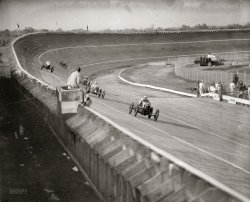
- All Aboard: 1930
- ... steam radiator to keep the crew warm on those long winter night runs.
Then a heavy wooden door, and a view back through the passenger ... Posted by Dave - 07/22/2012 - 6:46pm -
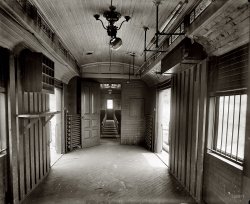
- Army Dually: 1918
- ...
Correction: Please excuse my two mistakes for I was on night shift without the photo in front of me. In the picture I was referring ... Posted by Dave - 07/24/2012 - 12:54pm -
![Army Dually: 1918 Washington, D.C., 1918. "Pershing, John J., General, U.S. Army -- his chauffeur." Harris & Ewing Collection glass negative. View full size.
Same car, France 1919My wife's grandfather, Bruce M. Strong, was Pershing's driver in France a year later in 1919. I have a photograph of Pershing, The Duke of Windsor, and my wife's grandfather with this same car somewhere in France, and yes, it has the disc wheels another member described on it. They are outside of the car and easy to recognize. Years later, Mr. Strong would visit Pershing at Walter Reed during his long stay there and was an honorary pallbearer at his funeral in 1948 at Washington D.C.
Correction: Please excuse my two mistakes for I was on night shift without the photo in front of me. In the picture I was referring to, the car still has the wire wheels.(I have another taken later with the disc wheels that caused the confusion.) It is the Prince of Wales(later Edward VIII) not the Duke of Windsor, though he had this title after giving up the throne.
Blackjack Pershing's carThat car survived, though while it was in service in France the wire wheels were replaced with disc wheels - huge globs of mud would become trapped in the wire spokes of the dual rear wire wheels, throwing them badly out of balance. The car (with its disc wheels) ended up on a farm in the Gilroy, California, area and was later owned for a long time by a musician for the San Francisco Opera; he stored it on the top floor of a bakery building on Van Ness Avenue.
Doughboy ThrillMany years ago, my maternal grandfather told me that one of his biggest thrills was the time his 36th Infantry Division (WW I) was reviewed by Pershing in France. Grandfather was from a small southwestern Oklahoma town (Doxey) that no longer exists today. Quite an experience for a farm boy!
The makeI forgot to say (and nobody else did) the car is a Locomobile Model 48, a very high quality machine from Bridgeport, Conn. They had BRONZE crankcases and transmission cases.
Pennsylvania AvenueThe car is parked in front of what was then the State, War, and Navy Building (now the Eisenhower Executive Office Building) on Pennsylvania Avenue just off the corner of 17th Street. The Renwick Gallery is the building in the background.
Dual Tires?Hard to tell with the shadows, but that sure looks like dual tires mounted on what is definitely a single, but wide, rim.
[Hence the title. - tterrace]
Overseas LimousinePershing's specially built Locomobile is purportedly on display at U.S. Army Ordnance Museum at the Aberdeen Proving Ground, but I can't verify that. Anyone been there lately?
U.S. Army Ordnance MuseumGeneral Pershing's Locomobile is part of the U.S. Army Ordnance Museum collection. The museum is in a state of transition from Aberdeen Proving Grounds in Maryland to Fort Lee in Virginia.
(The Gallery, Cars, Trucks, Buses, D.C., Harris + Ewing, WWI)](https://www.shorpy.com/files/images/SHORPY_12860a.thumbnail.jpg)























